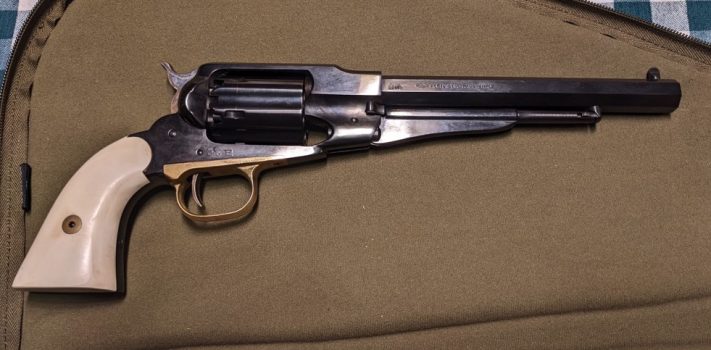Last summer, I tested a Pietta Blackpowder M1858 .44 Remington replica that I acquired from the Elk Creek Company. It was fun to shoot, interesting from a historical perspective, and is not classed as a “firearm” under Federal law. If there were a long-term technological setback, it would be easier to manufacture ammo for this replica than it would be for my more modern firearms.
Although shooting cap and ball revolvers is fun, loading them is a somewhat time-consuming process. It is easy to understand why most people select cartridge handguns over cap and ball revolvers if they have the choice.
The Backstory
I decided to dip my toe into the waters of black powder firearms because I had some purchase credits with Elk Creek Company. (I had been awarded those purchase credits as writing contest prizes, back before I came on board as a SurvivalBlog staff writer.)
I was inspired by SurvivalBlog contributor “M.B.”, who wrote an excellent four-part series entitled “Black Powder for Self-Reliance” back in October of 2019. (See: Part 1, Part 2, Part 3, and Part 4.)
Just three days after I placed my order, the revolver arrived via Priority Mail. The revolver could be shipped directly to me via USPS because according to Federal law, much like a pre-1899 gun, a cap and ball revolver is not a “firearm”. Instead, it is classified as an “antique” and hence it is outside of Federal jurisdiction. Note that a few states have restrictions on antique guns, so check before mail-ordering one.
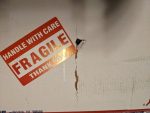 The box was prominently labeled “Fragile – Handle with Care” on all six sides. The US Postal Service disregarded that instruction. The 24″ x 12″ x ” inch shipping box was quite severely battered in transport. I opened it with fear and trepedation.
The box was prominently labeled “Fragile – Handle with Care” on all six sides. The US Postal Service disregarded that instruction. The 24″ x 12″ x ” inch shipping box was quite severely battered in transport. I opened it with fear and trepedation.
Opening the Box
The box contained a large olive green padded pistol case and a smaller package. The smaller package was a bonus gift, the novel Expatriates by James Wesley, Rawles. It is a hardcover edition, autographed by JWR. I am glad to have it, both because it is an excellent book, and because of the autograph.
The pistol case was approximately 18 inches long by 10 inches tall. I opened the case to find the revolver wrapped in bubble wrap along with a packet of silica desiccant. Inside the bubble wrap, the revolver was wrapped in an additional layer of paper. Because of the padded case, extra padding, and the very careful packing, the revolver was not at all damaged by the rough handling that it had received at the hands of the Postal Service.
I moved the hammer to half cock and rotated to cylinder to verify that none of the nipples were capped, and that all of the chambers were empty. I then removed the cylinder for closer examination.
There was the barest hint of carbon in one of the chambers, suggesting that the revolver had been fired at least once — perhaps a proof test at the factory. The remaining chambers, the bore, and the rest of the revolver were as clean as a whistle, and in like-new condition.
The steel parts are nicely blued, and the brass trigger guard provides a pleasant visual contrast. The white plastic grips are quite solid and effectively mimic bone or ivory.
The left side of the eight-inch octagonal barrel is stamped “Black Powder Only .44 Cal.” The right side of the frame and the right side of the barrel are stamped with various proof marks. The right side of the barrel is also stamped, “F. LLIPIETTA–MADE IN ITALY.”
The revolver has a fixed front sight, with the rear sight consisting of a groove in the top of the frame. The serial number is found on the bottom of the grip.
The inside of the frame behind the cylinder has some minor uneven spots. They appear to be casting marks that have not been polished off. They are insignificant, and not visible when the cylinder is in place.
The trigger is just a little heavy for a single-action revolver, but breaks smoothly. Just handling the revolver made me feel a little like Clint Eastwood in the 1985 movie Pale Rider. The cylinder was not initially as easy to remove and replace as Eastwood made it look with his M1858 in that movie, but with continued use and practice, the cylinder pin smoothed out and my removal and replacement skills grew.
Reading the Manual
I found a PDF of the Pietta manual on the Internet and printed it out. I then carefully read it in its entirety, except for the state-specific warnings and the sections that referred to other firearms. I found many useful items of information in the manual.
The manual recommends only loading five chambers, and carrying the revolver with the hammer down on the empty chamber.
It recommends not depending on the half cock as a safety.
It recommends not dry firing the revolver, since this may damage the nipples.
It recommends using soft lead balls only.
It notes that it is not safe to stand beside someone firing the revolver due to flames, hot gases, and potential percussion cap fragments.
It recommends waiting a full minute before re-priming in the event of a failure to fire, since instances of hang-fire may occur.
It recommends storing powder and percussion caps in separate locations.
It recommends keeping black powder containers closed on the firing line.
It notes that there are slits on the cylinder between the chambers. The hammer can be rested on these slits in order to avoid an unintentional discharge. According to the manual, it is considered a “DANGEROUS AND DELICATE STEP” to lower the hammer into one of these slits. It recommends resting the hammer on an empty chamber instead. It notes, “Always remember that these systems cannot be considered effective because they are not easy positions to find on the guns.”
The bullet must be firmly seated on the powder to prevent an explosion when the revolver is fired.
The proper powder to use in the revolver is 3f or FFFg.
The manual recommends handling black powder in small quantities, and notes that it “can be ignited by heat, spark, static electricity, friction, pressure, flame, etc.”
It recommends using a ball sized .454 with 12 to 15 grains of FFFg.
It recommends never carrying a capped cylinder (like Eastwood’s character, “Preacher”, did in Pale Rider), since it can accidentally discharge if struck.
The directions for loading and cleaning were very helpful. There was also a nice parts list with an exploded diagram of the revolver.
Tribulations
I had trouble finding appropriate black powder supplies in the medium-sized town near our home or online. I finally drove to a large sports store in the nearest metropolitan area. There I was able to buy enough powder, pistol balls, and wads for 100 shots. They did not have any percussion caps, and reported that they had not had any for about a year.
I asked a couple of my friends who are black powder shooters if they had any idea where I could find percussion caps. “Bman” referred me to a small hardware store out in the country. I was looking for either Remington #10 or CCI #11 caps. The hardware store had CC#10 and Winchester #11 caps. I decided to go with the Winchester caps.
The total cost of all my supplies came to more per round than I would pay for 9 mm ammo. So at that point, shooting black powder was not a less-expensive alternative than using my other handguns.
At the Range
I took the revolver to the informal range behind my barn for my first experience with shooting black powder. I prepared a target stand, set up a table 15 yards from the target, and set up a pistol rest.
I reviewed the portion of the manual regarding loading the revolver. It suggests a 12 to 15 grain powder charge. Prior to loading it suggested firing a cap on each nipple to clear oil from each nipple port and chamber.
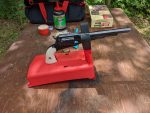 The Winchester caps were a little larger than I could have wished. They had a tendency to fall off the nipples. I begin bending the open end of the cap slightly prior to placing them on the nipples in order to help them grip the nipple more effectively. Prior to firing the caps, I put the lid back on the cap container to prevent a stray spark from igniting the extra caps.
The Winchester caps were a little larger than I could have wished. They had a tendency to fall off the nipples. I begin bending the open end of the cap slightly prior to placing them on the nipples in order to help them grip the nipple more effectively. Prior to firing the caps, I put the lid back on the cap container to prevent a stray spark from igniting the extra caps.
After firing the caps, I put 15 grains of Pyrodex P powder in one chamber, put a patch over the powder, and then put a lead ball over the patch. I then rotated the chamber under the loading lever plunger, and used the plunger to seat the ball in the chamber. This process shaved a thin ring of lead off the sides of the ball.
I filled the remainder of the chamber with an off-brand of “Crisco” (Carlini All-Vegetable Shortening). This helps to prevent sparks from the firing of one chamber from entering and igniting the powder in the other chambers. My friend, “Bman”, told about a “chain-fire” incident when he neglected this important step. Four of the five chambers on his revolver discharged at once, creating a significant fireball and burning his hand. He encouraged me to be diligent about sealing the chambers with an appropriate substance as recommended.
Next, I capped the loaded chamber, and made sure to let the hammer rest on the uncapped nipple of an empty chamber. I then verified that the powder container and the cap container were securely closed. Finally, I fired my first test shot from rest. The ball struck about five inches low and one inch to the right of the point of aim.
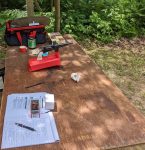 Next, I loaded five chambers using the procedure outlined above. I tested a 1/8 teaspoon measure, and discovered that it would hold about 14 grains of Pyrodex. I continued to transfer the powder from the 1/8 teaspoon measure into the powder measure to verify accuracy before pouring the powder into each chamber. The 1/8 teaspoon measure was not as accurate as the powder measure, but it did give me a quicker way of getting into the ballpark before moving small amounts of powder one way or the other.
Next, I loaded five chambers using the procedure outlined above. I tested a 1/8 teaspoon measure, and discovered that it would hold about 14 grains of Pyrodex. I continued to transfer the powder from the 1/8 teaspoon measure into the powder measure to verify accuracy before pouring the powder into each chamber. The 1/8 teaspoon measure was not as accurate as the powder measure, but it did give me a quicker way of getting into the ballpark before moving small amounts of powder one way or the other.
Once five chambers were loaded, I capped them, and rested the hammer on the uncapped nipple of the empty chamber. I then fired a five-shot group from rest.
As I fired, my view of the target was distorted by a cloud of hot gases, which then condensed into a fog of smoke. I gave the breeze a few moments to clear my view of the target following each shot.
After firing, a fair amount of shortening ended up on the frame of the revolver and on the pistol rest. With a heavy revolver and a light load, recoil was minimal. All the shots hit about five inches below the point of aim. In the future I will need to test if hotter loads strike closer to the point of aim. If they do not, I may need to file down the front sight a little to bring the point of impact closer to the point of aim.
Cleaning the Revolver
I went into the barn, filled an electric kettle with about half a gallon of water and turned the kettle on. While the water was heating, I put away the range table and target stand, and removed the cylinder, trigger guard, and grips from the revolver.
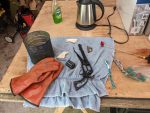 When the water boiled, I poured about half of it into a large empty coffee can along with a few drops of dish soap. I put on insulated rubber gloves, and then used a toothbrush and a cleaning rod with a patch to thoroughly scrub the bore and the rest of the revolver with the hot water. I then dumped out the soapy water, rinsed the coffee can, and re-filled it with plain hot water. I then used a fresh patch and the toothbrush to thoroughly rinse the bore and the rest of the revolver.
When the water boiled, I poured about half of it into a large empty coffee can along with a few drops of dish soap. I put on insulated rubber gloves, and then used a toothbrush and a cleaning rod with a patch to thoroughly scrub the bore and the rest of the revolver with the hot water. I then dumped out the soapy water, rinsed the coffee can, and re-filled it with plain hot water. I then used a fresh patch and the toothbrush to thoroughly rinse the bore and the rest of the revolver.
Next, I thoroughly dried the revolver with a dry patch through the bore and a dry towel for the rest. Finally, I cleaned the revolver normally with CLP, and reassembled it.
Conclusions
The Pietta M1858 was a lot of fun to shoot. Loading and cleaning the revolver were somewhat tortuous by modern standards. I am glad that technology has advanced beyond the cap and ball stage.
I already had experience using hot water to clean firearms since I have some ammo with corrosive primers. I don’t really enjoy the process. Something inside of me protests against intentionally exposing firearms to water.
I have always had good experiences ordering from Elk Creek Company, and recommend them as a good source for pre-1899 cartridge gun antiques and percussion replicas.
Disclaimer
SurvivalBlog Senior Editor JWR is the owner of Elk Creek Company. He gave me a good deal on the M1858, and provided some free extras like the pistol case and the novel Expatriates. I tried not to allow his kindness to influence my assessment of the revolver, and believe that I have succeeded in remaining objective.
I did not receive any other financial or other inducements to mention any vendor, product, or service in this article.
Note: In a future article, I will describe shooting this same revolver with a .45 Colt conversion cylinder.

